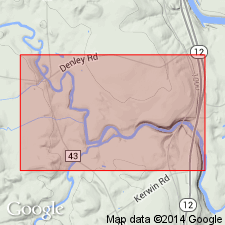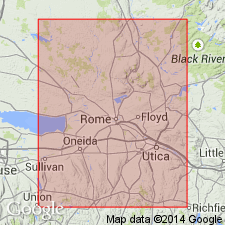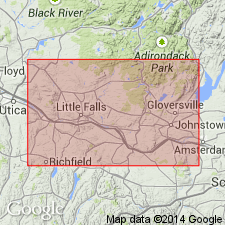
- Usage in publication:
-
- Denley Limestone
- Modifications:
-
- Named
- Dominant lithology:
-
- Limestone
- AAPG geologic province:
-
- Appalachian basin
Summary:
Denley Limestone of Trenton Group here named in Lewis Co., north-central NY. Consists predominantly of shaly calcarenite and marl. Greater than 60 m thick at type section on Sugar River. Subdivided into (ascending) Camp, Glendale, Poland, Russia, and Rust Members. (Camp and Glendale are only members present at type.) Overlies Sugar River Limestone (new) and underlies Steuben Limestone.
Source: GNU records (USGS DDS-6; Reston GNULEX).

- Usage in publication:
-
- Denley Limestone
- Modifications:
-
- Overview
- Revised
- AAPG geologic province:
-
- Appalachian basin
Summary:
Authors feel a refined, unified Trenton stratigraphy is essential. Applied here is a modified version of Kay's (1968) stratigraphic nomenclature. Poland Member at the base of Denley Limestone includes the informally named City Brook bed. Russia Member is divided into Wolf Hollow division (with North Gage Road bed at its base), Brayton Corners division, and High Falls Tongue. Rust Member remains the uppermost unit of the Denley and underlies the Steuben Limestone.
Source: GNU records (USGS DDS-6; Reston GNULEX).

- Usage in publication:
-
- Denley Limestone
- Modifications:
-
- Age modified
- Overview
- AAPG geologic province:
-
- Appalachian basin
Summary:
Revised stratigraphic correlations based on reinterpretation of graptolites and K-bentonites in the area suggest that the lower part of the Utica Shale is the lateral equivalent of a large part of the lower Trenton Group and is older than the Denley Limestone, with which it has been previously equated. The lower part of the Utica lies below the Dolgeville Formation in the central Mohawk Valley. The top of the Dolgeville is probably equivalent to the top of the Russia Member of the Denley, as suggested by Kay (1953) and Fisher (1979). The age of the Denley is shown as Middle and Late Ordovician (Shermanian and Edenian).
Source: GNU records (USGS DDS-6; Reston GNULEX).

- Usage in publication:
-
- Denley Limestone*
- Modifications:
-
- Overview
- Age modified
- AAPG geologic province:
-
- Appalachian basin
Summary:
Denley Limestone and its Glendale and Poland Members are used in this report. Age is refined to Champlainian (Shermanian).
Source: GNU records (USGS DDS-6; Reston GNULEX).
For more information, please contact Nancy Stamm, Geologic Names Committee Secretary.
Asterisk (*) indicates published by U.S. Geological Survey authors.
"No current usage" (†) implies that a name has been abandoned or has fallen into disuse. Former usage and, if known, replacement name given in parentheses ( ).
Slash (/) indicates name conflicts with nomenclatural guidelines (CSN, 1933; ACSN, 1961, 1970; NACSN, 1983, 2005, 2021). May be explained within brackets ([ ]).

